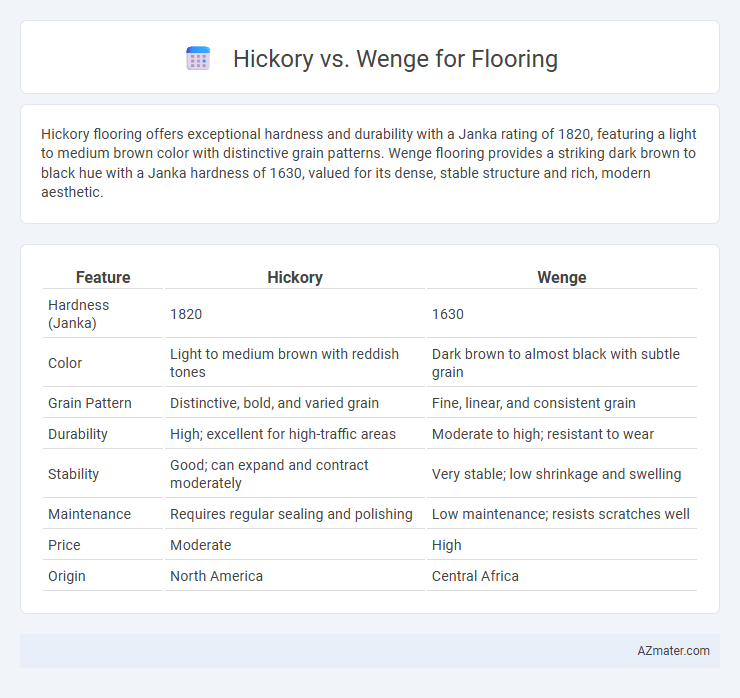Hickory flooring offers exceptional hardness and durability with a Janka rating of 1820, featuring a light to medium brown color with distinctive grain patterns. Wenge flooring provides a striking dark brown to black hue with a Janka hardness of 1630, valued for its dense, stable structure and rich, modern aesthetic.
Table of Comparison
| Feature | Hickory | Wenge |
|---|---|---|
| Hardness (Janka) | 1820 | 1630 |
| Color | Light to medium brown with reddish tones | Dark brown to almost black with subtle grain |
| Grain Pattern | Distinctive, bold, and varied grain | Fine, linear, and consistent grain |
| Durability | High; excellent for high-traffic areas | Moderate to high; resistant to wear |
| Stability | Good; can expand and contract moderately | Very stable; low shrinkage and swelling |
| Maintenance | Requires regular sealing and polishing | Low maintenance; resists scratches well |
| Price | Moderate | High |
| Origin | North America | Central Africa |
Hickory vs Wenge: An Introduction
Hickory and Wenge are two popular hardwood choices for flooring, each offering distinct characteristics and aesthetics. Hickory is known for its durability, high shock resistance, and light to medium brown color with striking grain patterns, making it ideal for high-traffic areas. Wenge features a rich, dark brown to black color with a fine, linear grain and offers a sophisticated, exotic look, though it is slightly less hard than Hickory, making it more suitable for moderate traffic spaces.
Visual Appearance and Color Differences
Hickory flooring displays a prominent grain pattern with warm tones ranging from creamy white to rich reddish-brown, creating a rustic and inviting aesthetic. Wenge flooring features a deep, dark brown color with subtle black streaks and a fine, straight grain, offering a sleek and modern appearance. The contrast between Hickory's lighter, more varied hues and Wenge's uniform, dark coloration makes them ideal for different interior design styles and lighting conditions.
Grain Patterns and Texture Comparison
Hickory flooring features prominent, bold grain patterns with a mix of straight and wavy lines, creating a dynamic and rustic aesthetic. Wenge flooring exhibits a fine, linear grain with subtle striping and a smooth texture, resulting in a sleek and modern appearance. The coarse texture of hickory contrasts with the dense, uniform texture of wenge, influencing both the tactile feel and the visual impact in interior spaces.
Hardness and Durability: Which Lasts Longer?
Hickory flooring boasts a hardness rating of 1820 on the Janka scale, making it one of the hardest domestic woods and highly resistant to dents and wear. Wenge, an exotic hardwood, has a Janka hardness of approximately 1630, offering substantial durability but slightly less resistance compared to Hickory. For high-traffic areas where longevity and toughness are critical, Hickory generally outlasts Wenge due to its superior hardness and abrasion resistance.
Maintenance and Care Requirements
Hickory flooring requires regular cleaning with a soft broom or vacuum and occasional refinishing to maintain its durability and resistance to wear. Wenge flooring demands careful maintenance due to its dense, dark wood, including gentle cleaning with a damp cloth and avoiding acidic or abrasive cleaners to preserve its rich color and texture. Both woods benefit from humidity control to prevent warping, but Hickory's harder surface tends to withstand dents and scratches better than Wenge.
Cost and Budget Considerations
Hickory flooring is generally more affordable, with prices ranging from $3 to $6 per square foot, making it a budget-friendly option for homeowners seeking durability and a classic look. Wenge, a rare exotic hardwood, commands higher prices between $8 and $15 per square foot due to its unique dark color and density, increasing overall installation costs. Budget considerations should also include maintenance expenses, as Wenge's hardness demands specialized care, potentially raising long-term costs compared to the more easily maintained Hickory.
Installation Process: Ease and Challenges
Hickory flooring offers moderate installation ease due to its hardness and natural variations, requiring precise acclimation and careful handling to avoid gaps or warping. Wenge, being a denser and more brittle exotic hardwood, presents challenges during cutting and nailing, often necessitating specialized tools and experienced installers to prevent splintering. Both materials demand acclimatization to humidity levels, but Wenge's sensitivity to moisture makes it more prone to expansion and contraction, requiring meticulous subfloor preparation for a stable installation.
Environmental Impact and Sustainability
Hickory flooring is often praised for its rapid growth rate and widespread availability, making it a more sustainable choice due to shorter harvest cycles and lower ecological disruption. Wenge, sourced primarily from Central African rainforests, carries significant environmental concerns including deforestation and habitat loss, with many suppliers adhering to strict certifications like FSC to mitigate these impacts. Choosing Hickory over Wenge can reduce environmental footprint, emphasizing renewable sourcing and promoting sustainable forest management.
Popular Applications and Design Styles
Hickory flooring is favored for rustic, farmhouse, and traditional interiors due to its durability and prominent grain patterns, making it ideal for high-traffic areas like living rooms and kitchens. Wenge flooring is popular in modern and contemporary design styles, offering a rich, dark hue that creates a sleek, sophisticated atmosphere in spaces such as offices and upscale residential rooms. Both materials complement diverse applications, with Hickory enhancing warm, natural aesthetics and Wenge providing bold, dramatic contrast.
Which is Best for Your Flooring Needs?
Hickory flooring offers exceptional hardness, durability rating around 1820 on the Janka scale, making it ideal for high-traffic areas and homes with pets or children. Wenge boasts a unique deep brown, almost black appearance with a Janka hardness of approximately 1630, providing a striking aesthetic but slightly less impact resistance than Hickory. Choosing between Hickory and Wenge depends on whether you prioritize maximum durability or distinctive visual appeal for your flooring needs.

Infographic: Hickory vs Wenge for Flooring
 azmater.com
azmater.com